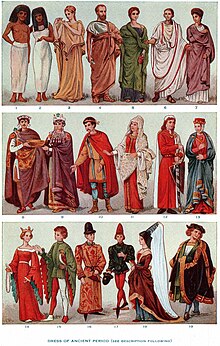
Cleidin (cried claes an attire an aa) is a collective term for garments, eetems worn on the bouk. Cleidin can be made o textiles, ainimal skin, or ither thin sheets o materials put thegither. The weirin o cleidin is mostly restrictit tae human beins an is a featur o nearly aw human societies. The amoont an teep o cleidin worn depend on bouk teepe, social, an geografic considerations. Some cleidin can be gender-speceefic.
Pheesically, cleidiin serves mony purposes: it can serve as pertection frae the elements an can enhance saufty in hazardous activities sic as hikin an cuikin. It pertects the weirer frae reuch surfaces, rush-causin plants, insect bites, sclinters, thorns an prickles bi providin a baurier atween the skin an the environment. Claes can insulate against cauld or het condeetions. Forder, thay can provide a hygienic baurier, keepin infectious an toxic materials awey frae the bouk. Cleidin forby provides pertection frae ultraviolet radiation. Weirin claes is a social norm an aa, as bein deprived o cleidin in front o ithers mey be embarrassin, or nae weirin claes in public tae the extent that genitals, breasts or buttocks are veesible coud be seen as indecent exposur.
| Wikimedia Commons haes media relatit tae Clothing. |